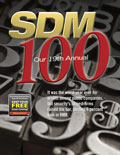
The headline read: “2008: ‘Worst Year’ In Fortune 500 History.” That’s a long spell — the Fortune 500 has been published since 1955.
Fortune 500 profits had reached an all-time high of $785 billion in 2006, according to the article, “Pop! Went the profit bubble,” posted on April 21 on CNNMoney.com. The plunge in profits between then and now was a staggering 87 percent drop to $98.9 billion.
Based on that report, which ranks publicly held firms based on public records, the financial community called 2008 the worst year in history for public companies. Even with that drastic profit decline, the Fortune 500 still earned more than 10 times in profit than what the entire SDM 100 earned in total gross revenues last year – $8 billion.
It’s not exactly a fair comparison. The SDM 100, a ranking by recurring monthly revenue (RMR) of the largest security dealer companies based in the United States, is comprised mostly of privately held businesses. (Ranked companies submit financial reports to SDM for verification.) Dealers earn their revenues from the sale, installation, service and monitoring of electronic security systems, such as intrusion and fire alarm, access control, video surveillance, and related low-voltage systems. Furthermore, the SDM 100 does not measure profit performance; it measures revenue performance.
Yet, we couldn’t resist pointing out the obvious contrast. The security industry has been notoriously considered “recession-proof.” If that belief is to be borne into fact, then today’s economy is the ultimate test. Their 2009 results may be more telling, but for year 2008 the SDM 100 gained 5 percent in total gross revenues and 6 percent in RMR.
Although some firms were forced to cut their labor force slightly in 2008, most remained even in their employee count or even increased it. Among the top-five-listed SDM 100 dealers, three of them actually added full-time employees.
Individually, security dealers also performed well: Comparing RMR between 2007 and 2008 shows that 89 percent improved, 10 percent declined, and 1 percent remained even. When comparing total gross revenues between 2007 and 2008, 72 percent of dealers had greater revenues, while 28 percent had lesser. (However, this is a significant fall off from the 91 percent that had greater revenues in 2007.)
Depending upon the area of the country and sector each dealer focuses on, SDM 100 companies offered different descriptions of how they fared in 2008. Some described the residential market as weak or flat, while others contended it was average or even said it was their strongest segment. Many expressed that the commercial market was most rewarding, but offered mixed opinions about whether gains were coming from small commercial, middle market or high-end engineered projects. One commonality among SDM 100 firms is the apparent good health of the fire alarm market. This is in contrast, however, to dealers who were interviewed for SDM’s “State of the Market: Fire Alarm” report.
No doubt that all could relate to the way one firm summarized the 2008 marketplace. “It was definitely more of a struggle, focusing on new ways to market and grow [our] existing client base,” reported No. 63, JMG Security Systems Inc., Fountain Valley, Calif., which experienced slight improvement in both RMR and total revenue.
Security dealers are now well into the second quarter of 2009. It’s a given that dealers will be working harder and smarter to show gains. Right now the industry is banking on the value of security outweighing financial concerns in the marketplace, as pointed out by No. 3, Protection One, a nationwide dealer headquartered in Lawrence, Kansas. “The market overall will be mostly flat, with gains in commercial offsetting contractions in residential. Given the importance of security to their business processes, commercial businesses will continue to invest to protect inventory and assets, as well as to monitor and improve employee productivity and safety.”
Fortune 500 profits had reached an all-time high of $785 billion in 2006, according to the article, “Pop! Went the profit bubble,” posted on April 21 on CNNMoney.com. The plunge in profits between then and now was a staggering 87 percent drop to $98.9 billion.
Based on that report, which ranks publicly held firms based on public records, the financial community called 2008 the worst year in history for public companies. Even with that drastic profit decline, the Fortune 500 still earned more than 10 times in profit than what the entire SDM 100 earned in total gross revenues last year – $8 billion.
It’s not exactly a fair comparison. The SDM 100, a ranking by recurring monthly revenue (RMR) of the largest security dealer companies based in the United States, is comprised mostly of privately held businesses. (Ranked companies submit financial reports to SDM for verification.) Dealers earn their revenues from the sale, installation, service and monitoring of electronic security systems, such as intrusion and fire alarm, access control, video surveillance, and related low-voltage systems. Furthermore, the SDM 100 does not measure profit performance; it measures revenue performance.
Yet, we couldn’t resist pointing out the obvious contrast. The security industry has been notoriously considered “recession-proof.” If that belief is to be borne into fact, then today’s economy is the ultimate test. Their 2009 results may be more telling, but for year 2008 the SDM 100 gained 5 percent in total gross revenues and 6 percent in RMR.
Although some firms were forced to cut their labor force slightly in 2008, most remained even in their employee count or even increased it. Among the top-five-listed SDM 100 dealers, three of them actually added full-time employees.
Individually, security dealers also performed well: Comparing RMR between 2007 and 2008 shows that 89 percent improved, 10 percent declined, and 1 percent remained even. When comparing total gross revenues between 2007 and 2008, 72 percent of dealers had greater revenues, while 28 percent had lesser. (However, this is a significant fall off from the 91 percent that had greater revenues in 2007.)
Depending upon the area of the country and sector each dealer focuses on, SDM 100 companies offered different descriptions of how they fared in 2008. Some described the residential market as weak or flat, while others contended it was average or even said it was their strongest segment. Many expressed that the commercial market was most rewarding, but offered mixed opinions about whether gains were coming from small commercial, middle market or high-end engineered projects. One commonality among SDM 100 firms is the apparent good health of the fire alarm market. This is in contrast, however, to dealers who were interviewed for SDM’s “State of the Market: Fire Alarm” report.
No doubt that all could relate to the way one firm summarized the 2008 marketplace. “It was definitely more of a struggle, focusing on new ways to market and grow [our] existing client base,” reported No. 63, JMG Security Systems Inc., Fountain Valley, Calif., which experienced slight improvement in both RMR and total revenue.
Security dealers are now well into the second quarter of 2009. It’s a given that dealers will be working harder and smarter to show gains. Right now the industry is banking on the value of security outweighing financial concerns in the marketplace, as pointed out by No. 3, Protection One, a nationwide dealer headquartered in Lawrence, Kansas. “The market overall will be mostly flat, with gains in commercial offsetting contractions in residential. Given the importance of security to their business processes, commercial businesses will continue to invest to protect inventory and assets, as well as to monitor and improve employee productivity and safety.”


